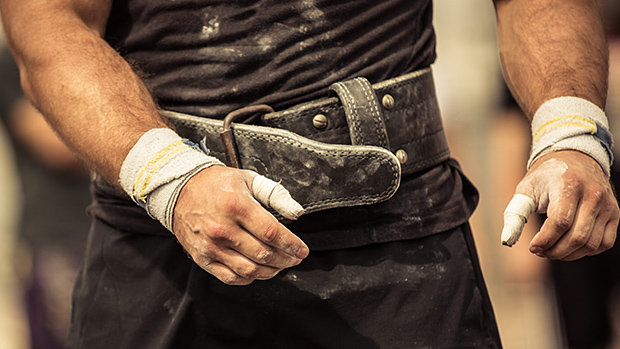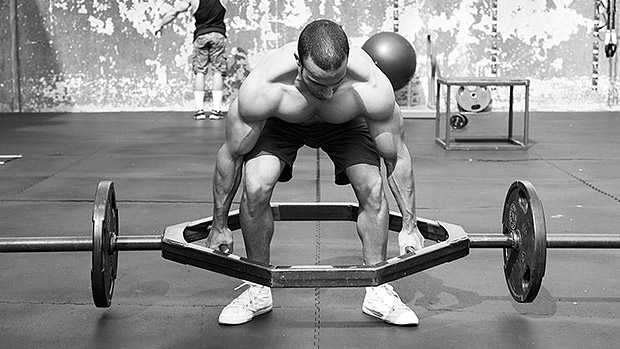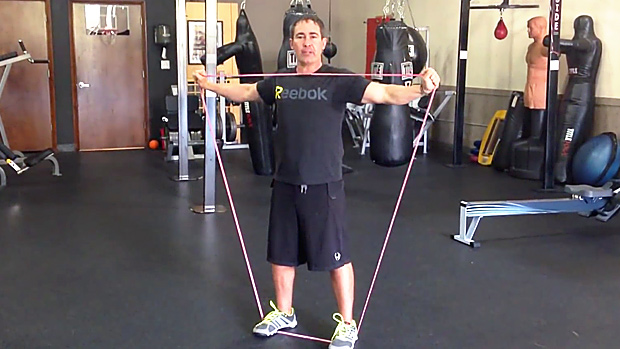Should Your Arm Workout Contain Partial Reps?
A cool study from 2019 should have changed the way all of us train arms (at least triceps), but for some reason didn't. It compared partial reps to full-range reps and found that the former seemed to duplicate the effects of occlusion training (blood flow restriction) and result in greater muscle growth than full-range reps. Here are the details:
If you haven't tried occlusion training, you've probably at least thought about it. Sure, all you've got to do is find some tubing and wrap it around your arm.
Easier said than done. It's uncomfortable and awkward, and the average lifter has no idea of how tight the elastic is supposed to wrap around his arm, unless he buys a pricy dedicated device.
But partial reps? No such device is necessary, and a team of Japanese scientists found that they work as well (or at least in a similar way) to blood flow restriction training.
Masahiro Goto and his colleagues recruited 44 young, trained men and divided them into two groups. One was a partial rep group (elbow range from 45 degrees to 90 degrees), and the other was a full-range group (elbow range 0 degrees to 120 degrees).
Here's what both ranges look like:
Each group did 3 sets of lying triceps extensions for 8 reps (using their 8-rep maximum) three times a week for 8 weeks. They also made adjustments to the intensity used on the first day of each week.
The partial rep protocol resulted in higher blood lactate levels, "greater area under the oxygenated hemoglobin curve" (a curve that plots the percentage of hemoglobin in its oxygen-filled state), and a greater "root-mean-square of electromyography" (which reflects the physiological activity during contraction).
All good, but here's the money shot: The partial rep protocol led to greater increases in cross-sectional area of the triceps, along with a greater increase in triceps isometric strength.
Let's get back to classical blood-flow restriction training again for a minute. A band or tourniquet slows down the movement of blood that's flowing back to the heart. This allows the blood to "back up" in the limbs, i.e., they become engorged with blood.
This "backed up" blood increases the concentration of lactate in the occluded area, which tricks the brain into thinking the muscles are working out a lot harder than they are. In turn, the pituitary allegedly releases additional amounts of growth hormone (GH), IGF-1, mTOR, and myostatin, all of which play a big role in muscle growth.
Much the same happens during partial reps. In effect, the style of training "kinks the hose" and blood occludes in the working muscle.
Goto and his colleagues, however, maintain that "hypoxic muscle stimulation" (stimulation of growth through low blood-oxygen levels) is also important during conventional training as it occurs, to some degree, even when you're doing full-range reps.
However, the more advanced you are training-wise, the bigger your artery diameters are (to a point). This results in blood flowing freely – too freely – through those big, garden hose arteries. As a result, there's not even a hint of occlusion and you get a diminished growth response.
This doesn't appear to be pure conjecture, either. One of their previous studies found that 8 weeks of training resulted in just that – an increase in artery diameter and blood flow, leading to "blunted hypoxic muscle stimulation."
Not only that, but there's the plain physics of conventional training that possibly blunts the growth response: Every time your limb reaches 180-degree extension (when your arm is straight out from your body), you "unkink" the hoses and allow arteries and capillaries to decompress, thus allowing the blood to flow freely (no occlusion). No occlusion, no GH, IGF-1, etc.
Hence the beauty of partial reps – constant muscular contractions, which results in plenty of occlusion, leading to greater mechanical and metabolic stress (than full range of motion reps), and, subsequently, greater growth.
It only takes a very small leap of faith to assume that partial rep training would affect the biceps the same way, but what about your wheels? Why not partial-rep squats to spur them into newfound growth?
Good idea, but it seems the anatomy of the legs makes partial reps during squats (or, presumably, any other squat-like movement) unnecessary. As Goto and his associates explained:
"Energy metabolism during squatting is possibly different from the lying elbow extension. This is because squatting exercise is performed in the basal plane, and continuous muscle contraction can be performed even in the final range of motion where the moment arm (the length between a joint axis and the line of force acting on that joint) reached the longest point."
That means that squatting exerts a greater stretch on the quadriceps, resulting in some occlusion and muscle hypoxia. It also helps explain why honest, fully committed quad training burns like hellfire.
However, it seems logical to presume that partial-rep training would cause some occlusion during exercises like leg extensions and perhaps hamstring curls.
There are at least a couple of ways to incorporate partial reps into your training. You can either do sets exclusively dedicated to partial reps, or you can simply top off your last set of any triceps or biceps exercise with a partial-rep extravaganza blow-out that leaves the muscles quivering, begging for the sweet relief of oxygen-rich hemoglobin.
- Masahiro G et al. Partial range of motion exercise is effective for facilitating muscle hypertrophy and function via sustained intramuscular hypoxia in young trained men. Strength Cond Res. 2019 May;33(5):1286-1294. PubMed.
T Nation earns from qualifying purchases as an Amazon Associate. Read more about our policy.




